Innovative Designs in Pre Fabricated Steel Buildings
The demand for pre fabricated steel buildings has surged in recent years, and with it, the need for innovative design solutions. Pre fabricated steel buildings have evolved from simple, functional structures to complex, customized designs that meet various architectural and aesthetic needs. These buildings now blend cutting-edge technology with versatility, durability, and sustainability, making them an ideal choice for diverse construction projects, including commercial, industrial, and residential applications. Here, we’ll explore some of the most exciting innovations in pre fabricated steel buildings and how they’re reshaping modern construction. 1. Customizable and Modular Designs One of the most significant innovations in pre fabricated steel buildings is the flexibility to create customized, modular designs. Unlike traditional construction, which can be rigid and time-consuming, pre-fabricated structures offer the ability to design and configure buildings based on specific proj...
